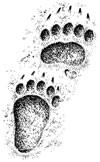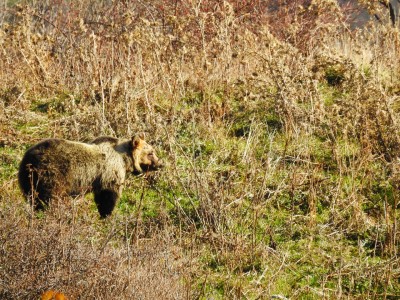Marsican Brown Bear
Identity card
Name
Brown Bear (Ursus arctos marsicanus)
Age
In nature can live about 20 years.
Habitat
The beech forests of the National Park of Abruzzo, Lazio and Molise and surrounding areas. In terms of its food needs accomplishes large displacements , the high-altitude meadows in summer, up to the warmer areas of valley.
Weight
Varies considerably over the seasons and as a function of sex. In fact, the males are generally much larger than females and can reach a weight in the autumn exceed 230kg. The females on the other hand rarely exceed 140 Kg.
Height
The larger males when they assume the upright position (in case of an alarm, to the Magyar from the branches of a tree, etc…) Can exceed 2 meters in height. The females are considerably more little.
Feed
Even if the bear is called an omnivore, its diet consists mainly of plants (grass, fruit, berries, etc…). His favorite is definitely the buckthorn berry (ramnus alpina), which mature in late summer in the mountains of the Park and which makes great feasting. Completing his feeding insects, honey and meat. The Brown Bear can not be classified as a pure predator because they generally feed on carcasses and only rarely ventures into predations of wild animals. The situation is different for domestic animals (sheep, chickens, etc…) That sometimes fall victim of the claws of the bear.
Reproduction and parental care
Mating season falls in late spring (May-June). During this period the female is courted and mates with several males, so that the litter that will produce could have different fathers. During this period, the males follow the female for several weeks, trying to prevail over his rival and win the sympathies of the bear. The puppies (one to three) are born in the winter period, during hibernation, and their weight does not exceed 500 g. They usually stay with the mother for about a year and a half, and during this period the mother will raise them with care and attention.
Signs of the presence
Traces (front footprint visibly different from backfootprint), excrement (change of shape and color based on what the bear eats), overturned stones (to look for insects), hair and scratches.
Estimated population
In the Park and the surrounding areas an estimated population of about 40-60 bears. With approximately 10-12 females of reproductive age.
Curiosity
Lethargy is a waking sleep that concerns the bear in winter, allowing them to save a lot of energy. The heart rate is significantly reduced, the body temperature drops a few degrees, but what is most surprising is that the bear in the spring is able to get up and immediately resume his rounds, despite the 3-5 months of inactivity due to lethargy.
Diapause: the reproduction of the bear. The egg fertilized in late spring does not develop immediately, but the actual pregnancy begins only in late summer, when food resources are more abundant, and the mother may carry the pregnancy with greater ease. Gestation real hard just a few months, so the newborn puppies do not exceed 500g.
Hyperphagia: the bear trend to eat a lot in the summer and autumn to accumulate fat profits to survive the winter. Tips for observation Bear elusive and solitary by nature do not like to be disturbed, then groped in the observation always recommend that you rely on professionals. Certainly not for his character, who is meek and quiet, but only for not to disturb him and to be able to fully appreciate the value. The best times to observations are the spring, where you can see it grazing in the clearings of low altitude and in late summer, while it feeds on its favourite berries. We recommend that you always remarks at a fair distance, perhaps with the help of binoculars and monoculars and also advise you not to "perfume" too much because the bear has a highly developed sense of smell.
Tips for observation
The bear solitary and elusive character does not like to be disturbed, then groped in the observation always recommend that you rely on professionals. Certainly not for his character, who is meek and quiet, but only as not to disturb and to be able to fully appreciate the value. The best times to observations are the spring, where you can see it grazing in the clearings of low altitude and in late summer, while it feeds on its favourite berries. We recommend that you always remarks at a fair distance, perhaps with the help of binoculars and monoculars and also advise you not to "perfume" too much because the bear has a highly developed sense of smell.
Fingerprints



